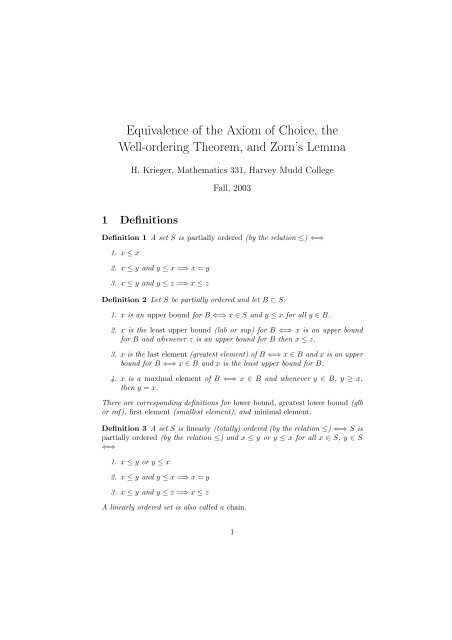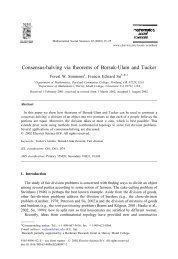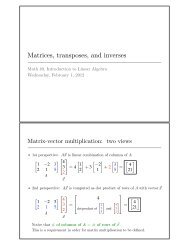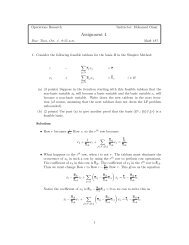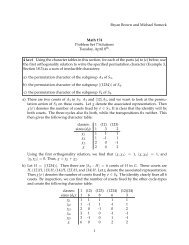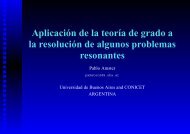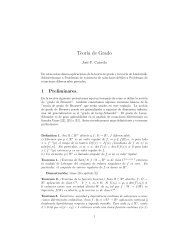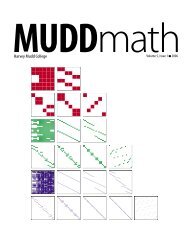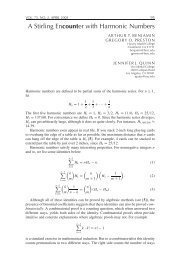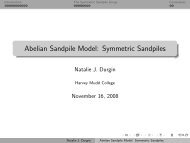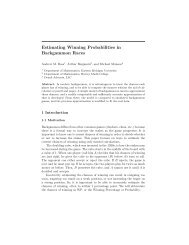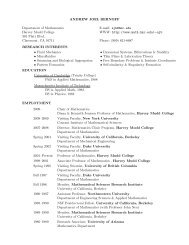Equivalence of the Axiom of Choice, the Well-ordering Theorem ...
Equivalence of the Axiom of Choice, the Well-ordering Theorem ...
Equivalence of the Axiom of Choice, the Well-ordering Theorem ...
Create successful ePaper yourself
Turn your PDF publications into a flip-book with our unique Google optimized e-Paper software.
<strong>Equivalence</strong> <strong>of</strong> <strong>the</strong> <strong>Axiom</strong> <strong>of</strong> <strong>Choice</strong>, <strong>the</strong><br />
<strong>Well</strong>-<strong>ordering</strong> <strong>Theorem</strong>, and Zorn’s Lemma<br />
H. Krieger, Ma<strong>the</strong>matics 331, Harvey Mudd College<br />
1 Definitions<br />
Fall, 2003<br />
Definition 1 A set S is partially ordered (by <strong>the</strong> relation ≤) ⇐⇒<br />
1. x ≤ x<br />
2. x ≤ y and y ≤ x =⇒ x = y<br />
3. x ≤ y and y ≤ z =⇒ x ≤ z<br />
Definition 2 Let S be partially ordered and let B ⊂ S.<br />
1. x is an upper bound for B ⇐⇒ x ∈ S and y ≤ x for all y ∈ B.<br />
2. x is <strong>the</strong> least upper bound (lub or sup) for B ⇐⇒ x is an upper bound<br />
for B and whenever z is an upper bound for B <strong>the</strong>n x ≤ z.<br />
3. x is <strong>the</strong> last element (greatest element) <strong>of</strong> B ⇐⇒ x ∈ B and x is an upper<br />
bound for B ⇐⇒ x ∈ B and x is <strong>the</strong> least upper bound for B.<br />
4. x is a maximal element <strong>of</strong> B ⇐⇒ x ∈ B and whenever y ∈ B, y ≥ x,<br />
<strong>the</strong>n y = x.<br />
There are corresponding definitions for lower bound, greatest lower bound (glb<br />
or inf), first element (smallest element), and minimal element.<br />
Definition 3 A set S is linearly (totally) ordered (by <strong>the</strong> relation ≤) ⇐⇒ S is<br />
partially ordered (by <strong>the</strong> relation ≤) and x ≤ y or y ≤ x for all x ∈ S, y ∈ S<br />
⇐⇒<br />
1. x ≤ y or y ≤ x<br />
2. x ≤ y and y ≤ x =⇒ x = y<br />
3. x ≤ y and y ≤ z =⇒ x ≤ z<br />
A linearly ordered set is also called a chain.<br />
1
Definition 4 A set S is well ordered (by <strong>the</strong> relation ≤)⇐⇒ S is partially<br />
ordered (by <strong>the</strong> relation ≤) and every non-empty subset <strong>of</strong> S has a first element<br />
⇐⇒ S is linearly ordered (by <strong>the</strong> relation ≤) and every non-empty subset <strong>of</strong> S<br />
has a first element.<br />
Definition 5 A set S is inductively ordered (by <strong>the</strong> relation ≤) ⇐⇒ S is partially<br />
ordered (by <strong>the</strong> relation ≤) and every linearly ordered subset (chain) in S<br />
has a least upper bound.<br />
2 <strong>Theorem</strong> Statements<br />
W.O.T. Every set can be well-ordered.<br />
A.C.1. If S is a non-empty collection <strong>of</strong> disjoint non-empty sets S, <strong>the</strong>n <strong>the</strong>re<br />
is a set R which has as its elements exactly one element x from each set<br />
S in S.<br />
A.C.2. If S is a non-empty collection <strong>of</strong> non-empty sets A, <strong>the</strong>n <strong>the</strong>re is a<br />
function ϕ : S → ∪{A : A ∈ S} such that ϕ(A) ∈ A for all A ∈ S.<br />
A.C.3. If I is a non-empty set and, for each i ∈ I, Si is a non-empty set, <strong>the</strong>n<br />
<strong>the</strong> cartesian product<br />
<br />
Si = {f : I → ∪{Si : i ∈ I} such that f(i) ∈ Si for all i ∈ I}<br />
i∈I<br />
is non-empty.<br />
Z.L.1. If S is a partially ordered set such that each chain in S has an upper<br />
bound, <strong>the</strong>n S has a maximal element.<br />
Z.L.2. If S is inductively ordered, <strong>the</strong>n S has a maximal element.<br />
3 <strong>Equivalence</strong> <strong>of</strong> <strong>the</strong>se Statements<br />
A.C.3. =⇒ A.C.2. Since <strong>the</strong> cartesian product {A : A ∈ S} is non-empty,<br />
<strong>the</strong>re is a function ϕ : S → ∪{A : A ∈ S} such that ϕ(A) ∈ A for all<br />
A ∈ S.<br />
A.C.2. =⇒ A.C.1. Since <strong>the</strong>re is a function ϕ : S → ∪{S : S ∈ S} such that<br />
ϕ(S) ∈ S for all S ∈ S and <strong>the</strong> sets in in S are disjoint, <strong>the</strong> range R <strong>of</strong> ϕ<br />
is a set which has for its elements exactly one element from each set S in<br />
S.<br />
A.C.1. =⇒ A.C.3. For each i ∈ I, <strong>the</strong> set Ti = {(i, x) : x ∈ Si} is non-empty.<br />
Thus <strong>the</strong> collection S = {Ti : i ∈ I} is a non-empty collection <strong>of</strong> disjoint<br />
non-empty sets. Hence <strong>the</strong>re is a set f which has as its elements exactly<br />
one element (i, f(i)) from each set Ti. Then f : I → {Si : i ∈ I} with<br />
f(i) ∈ Si for all i ∈ I.<br />
2
Z.L.1. =⇒ Z.L.2. If S is inductively ordered, <strong>the</strong>n every chain in S has an<br />
upper bound. Thus S has a maximal element.<br />
Z.L.2. =⇒ Z.L.1. Suppose S is partially ordered and every chain in S has an<br />
upper bound. Let T = {C : C is a chain in S}. Since T ⊂ 2 S and 2 S<br />
is partially ordered by inclusion, so is T . If C0 is a maximal element <strong>of</strong><br />
T , <strong>the</strong>n <strong>the</strong>re is an upper bound x0 for C0. Then x0 ∈ C0 and x0 is a<br />
maximal element <strong>of</strong> S. Hence our problem is reduced to showing that T<br />
has a maximal element. But if C is a chain in T and C0 = ∪{C : C ∈ C},<br />
<strong>the</strong>n C0 is <strong>the</strong> least upper bound <strong>of</strong> C. Hence T is inductively ordered<br />
which means T does have a maximal element.<br />
W.O.T. =⇒ A.C.2. Let S be a non-empty collection <strong>of</strong> non-empty sets A.<br />
Let S = ∪{A : A ∈ S} and, <strong>the</strong>n, well-order S. Hence each A is <strong>the</strong>n a<br />
non-empty subset <strong>of</strong> <strong>the</strong> well-ordered set S. If ϕ(A) is <strong>the</strong> first element <strong>of</strong><br />
A, <strong>the</strong>n ϕ : S → ∪{A : A ∈ S} such that ϕ(A) ∈ A for all A ∈ S.<br />
Z.L.2. =⇒ W.O.T. Let S be a set. For each subset A <strong>of</strong> S which can be<br />
well-ordered, let WA be <strong>the</strong> collection <strong>of</strong> well-<strong>ordering</strong>s <strong>of</strong> A and <strong>the</strong>n let<br />
W = {(A, ≤A) : A ⊂ S, ≤A∈ WA}.<br />
Define a partial <strong>ordering</strong> on W by letting (A, ≤A) ≤ (B, ≤B)<br />
⇐⇒ A ⊂ B, ≤A=≤B |A, and a ∈ A, b ∈ B − A =⇒ a ≤B b.<br />
Now if C is a chain in W , C = {(C, ≤C)}, let C0 = ∪{C : (C, ≤C) ∈ C}<br />
and let ≤C0= ∪{≤C: (C, ≤C) ∈ C}, i.e. if x and y are in C0, <strong>the</strong>n<br />
x ≤C0 y ⇐⇒ x ≤C y for some C such that (C, ≤C) ∈ C. Then ≤C0 is a<br />
well-<strong>ordering</strong> <strong>of</strong> C0 and (C0, ≤C0) is <strong>the</strong> least upper bound <strong>of</strong> C. Hence,<br />
W is inductively ordered which means that W has a maximal element.<br />
Let (A, ≤A) be a maximal element <strong>of</strong> W . Then A = S, for if S − A = φ,<br />
we consider B = A ∪ {x}, where x ∈ S − A, and define ≤B by y ≤B x<br />
for all y ∈ A, ≤B |A =≤A. However, in this case (A, ≤A) ≤ (B, ≤B) and<br />
(A, ≤A) = (B, ≤B). Hence, (S, ≤S) ∈ W for some well-<strong>ordering</strong> ≤S, i.e.<br />
S can be well-ordered.<br />
Lemma: Let S be inductively ordered and let f : S → S such that f(x) ≥ x<br />
for every x ∈ S. Then <strong>the</strong>re is an x0 ∈ S such that f(x0) = x0. In fact, if<br />
a ∈ S, <strong>the</strong>re is an x0 ≥ a such that f(x0) = x0.<br />
Pro<strong>of</strong>: Let a ∈ S and let Ba be <strong>the</strong> collection <strong>of</strong> all subsets B <strong>of</strong> S such that<br />
i) a ∈ B,<br />
ii) f[B] ⊂ B,<br />
iii) if C is a chain in B, <strong>the</strong>n lub C ∈ B.<br />
3
Note that Ba is not empty, since {x : x ≥ a} ∈ Ba. Let A = ∩{B : B ∈<br />
Ba}. Then it is easy to see that A ∈ Ba. Our objective is to show that A<br />
is a chain, for <strong>the</strong>n if x0 = lub A, it follows that x0 ∈ A =⇒ f(x0) ≤ x0 ≤<br />
f(x0), i.e. f(x0) = x0. The intuitive idea is that A consists only <strong>of</strong> a and<br />
its successive images under f. Hence, we let<br />
P = {p ∈ A : y ∈ A and y < p =⇒ f(y) ≤ p}.<br />
Note that P ⊂ A but we would like to have equality. As a start, we show<br />
that if p ∈ P and z ∈ A, <strong>the</strong>n ei<strong>the</strong>r z ≤ p or z ≥ f(p) (i.e. elements <strong>of</strong> P<br />
and A are comparable and <strong>the</strong>re are no elements <strong>of</strong> A between p and f(p)<br />
if p ∈ P ). To see this, let p ∈ P and let<br />
Then,<br />
i) a ≤ p =⇒ a ∈ B(p).<br />
B(p) = {z ∈ A : ei<strong>the</strong>r z ≤ p or z ≥ f(p)}.<br />
ii) If z ∈ A and z < p, <strong>the</strong>n f(z) ≤ p; if z ∈ A and z = p, <strong>the</strong>n<br />
f(z) = f(p) ≥ f(p); if z ∈ A and z ≥ f(p), <strong>the</strong>n f(z) ≥ z ≥ f(p).<br />
Hence, z ∈ B(p) =⇒ f(z) ∈ B(p), i.e., f[B(p)] ⊂ B(p).<br />
iii) Let C be a chain in B(p) and let c0 = lub C. Then c0 ∈ A. If c ≤ p<br />
for all c ∈ C, <strong>the</strong>n c0 ≤ p =⇒ c0 ∈ B(p). O<strong>the</strong>rwise, <strong>the</strong>re is some<br />
c ∈ C such that c ≥ f(p) =⇒ c0 ≥ c ≥ f(p) =⇒ c0 ∈ B(p). Thus<br />
c0 = lub C ∈ B(p). Consequently, B(p) ∈ Ba and, since B(p) ⊂ A,<br />
we have B(p) = A.<br />
Now we can show that P = A.<br />
i) a ∈ P since <strong>the</strong>re is no y ∈ A with y < a.<br />
ii) Let p ∈ P . Suppose that y ∈ A and y < f(p). Note that f(p) ∈ A.<br />
Then we must have y ≤ p. If y < p <strong>the</strong>n f(y) ≤ p ≤ f(p) and if<br />
y = p <strong>the</strong>n f(y) = f(p) ≤ f(p). Hence f(p) ∈ P , i.e. f[P ] ⊂ P .<br />
iii) Let C be a chain in P . Then c0 = lub C ∈ A. Suppose that y ∈ A<br />
and y < c0. If y ∈ P , <strong>the</strong>n c0 ≥ f(y). O<strong>the</strong>rwise, for each c ∈ C,<br />
ei<strong>the</strong>r y < c or y ≥ f(c) ≥ c. But we can’t have y ≥ c for all c ∈ C,<br />
since c0 = lub C. Hence, for some c ∈ C, y < c =⇒ f(y) ≤ c ≤ c0.<br />
Therefore, c0 ∈ P .<br />
Consequently, P ∈ Ba and, since P ⊂ A, we have P = A. Finally, if x ∈ A<br />
and y ∈ A, <strong>the</strong>n ei<strong>the</strong>r x ≤ y or x ≥ f(y) ≥ y and hence A is a chain.<br />
A.C.2. =⇒ Z.L.2. let S be inductively ordered. Let S be <strong>the</strong> collection <strong>of</strong> all<br />
non-empty subsets <strong>of</strong> S and let ϕ : S → ∪{A : A ∈ S} be a mapping with<br />
ϕ(A) ∈ A for all A ∈ S. Define f : S → S by letting f(x) = x if x is a<br />
maximal element and letting f(x) = ϕ({y : y > x}) if x is not a maximal<br />
element. Then f(x) ≥ x for all x ∈ S. Hence by <strong>the</strong> lemma, <strong>the</strong>re is an<br />
x0 ∈ S such that f(x0) = x0. Then, x0 must be a maximal element <strong>of</strong> S.<br />
4


